Glass: The Currency of Engagement
Today’s modern workplace, led by technology companies, is more campus than office building with landscaped grounds, workplace lounges and open floor plans meant to encourage employee communication and collaboration.
Yet some companies, a recent study documents, are finding that too much openness hinders employee concentration and that the best settings make room for collaboration and privacy.
We see the same trends unfolding in new and renovated campus buildings, but institutions haven’t changed as quickly or dramatically as tech companies so they don’t have to backtrack. Faculty, many of whom have long taught in classrooms behind closed doors with maybe only a window, have been a thoughtful brake on going too far, too fast.
Still, we see more facets of “open” design infiltrating campuses, and we think for the better. Study after study has indicated that more engaged students are better students. There are many ways to increase student engagement. Sometimes, only a good book or intriguing research question is needed. Yet the space we inhabit matters, too, and the correct environment can greatly impact teaching, learning and student engagement.
That’s why we’re pleased to see more campus spaces that encourage engagement via:
Increased transparency.
Here, we’re talking glass, which we see as the currency of engagement. Windowless classrooms and walled off dining and other social areas are no longer the norm for new design. Formerly introverted spaces are extroverted – visually open, connected, and bathed in natural light. Glass makes visual connections happen and transmits the energy of activity.
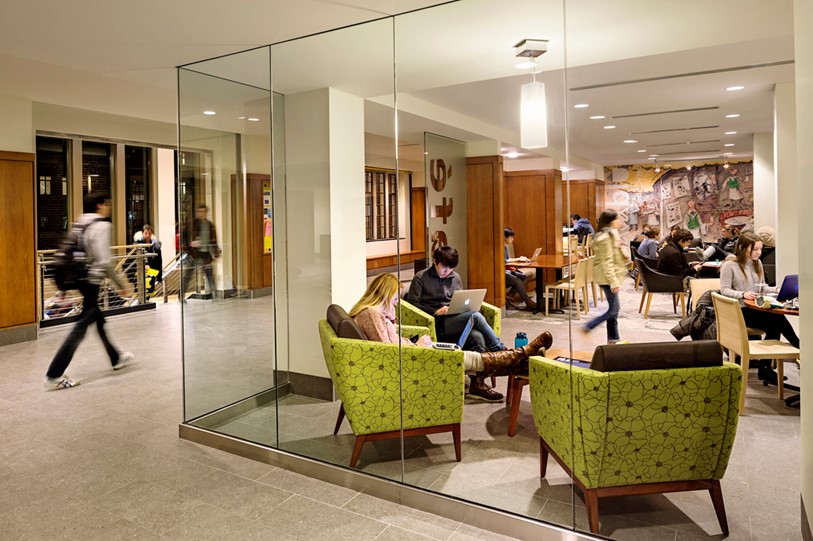
We’ve taken advantage of advancements in glass technology to bring more natural daylight into classrooms, labs, dining areas and other spaces. Computer simulation and energy modeling allows us to configure shading and shape the building to capture day light with predictable outcomes and without compromising energy performance.
The positive impacts of natural daylight on student health and performance has been well documented. One study analyzed test scores of more than 21,000 students in three school districts in California, Washington, and Colorado. In one of the districts, students with the most daylight in their classrooms progressed 20 percent faster on math tests and 26 percent faster on reading tests verses students with the least daylight.
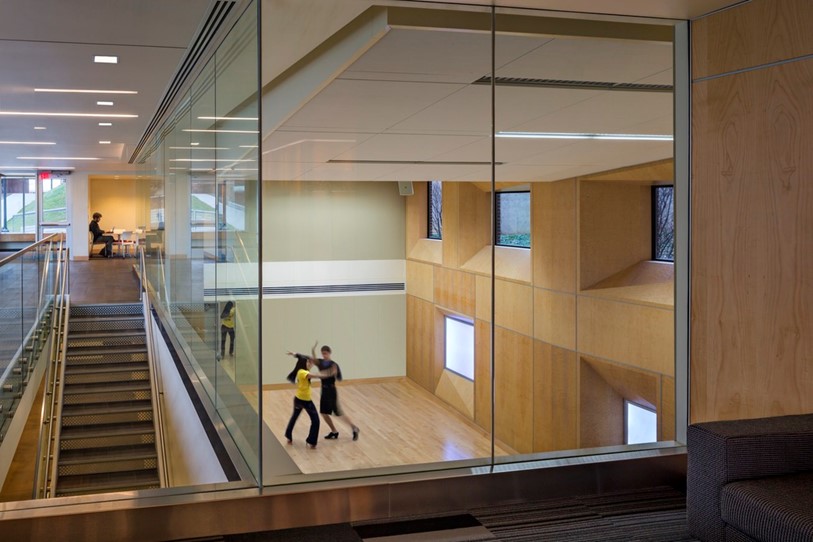
Beyond the benefits of natural light, glass enhances feelings of transparency. We’ve seen glass fundamentally alter connectivity between spaces, often linking casual, passive observation with active program activities. Imagine entering an introverted walled-off space without knowing who is inside or what is going on, and how hard that can be to do. With glass, students can see who is in a space and what’s going on, which may encourage them to enter and join in.
One must also consider today’s student. They’re enamored with social media and texting, which enables them to know where their friends are at all times. Likewise, spaces that use glass enable students to see their peers as well as to be seen by them.
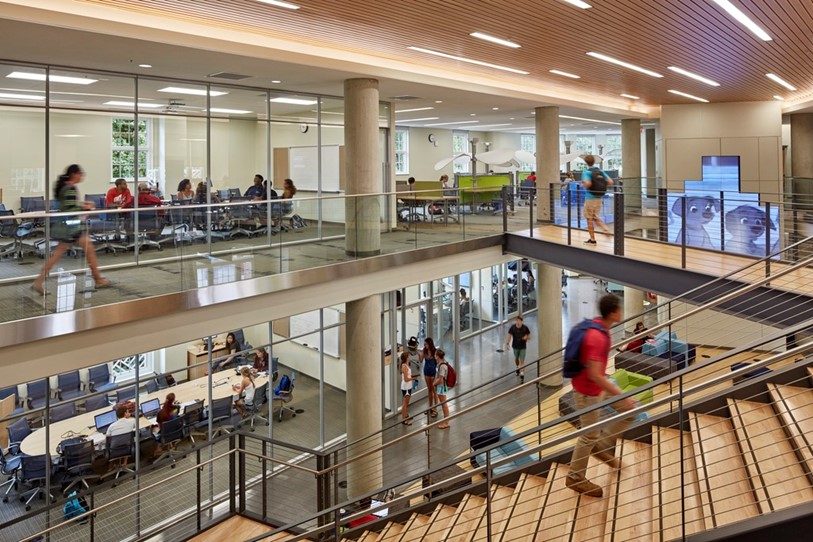
Rice University’s newest dining hall is glass on three sides. Diners inside see who is outside and vice versa. From one table, a student can connect with someone at the same table, someone walking by, even if they’re outside, and whoever they’re texting—all at the same time. Now that is engaged.
Speaking of walking by, campus pathways seem to be far more intentional these days. Rather than just connect campus facilities, they pass by, around, and even through buildings and program spaces. If glass is present, the pathway experience is animated. Glass allows the visual connection—the invitation—that engages. Exposed to all types of campus activity, students observe, jump in, follow from afar, or become inspired to do their own thing. If glass had not allowed them to engage, they might have only walked by.
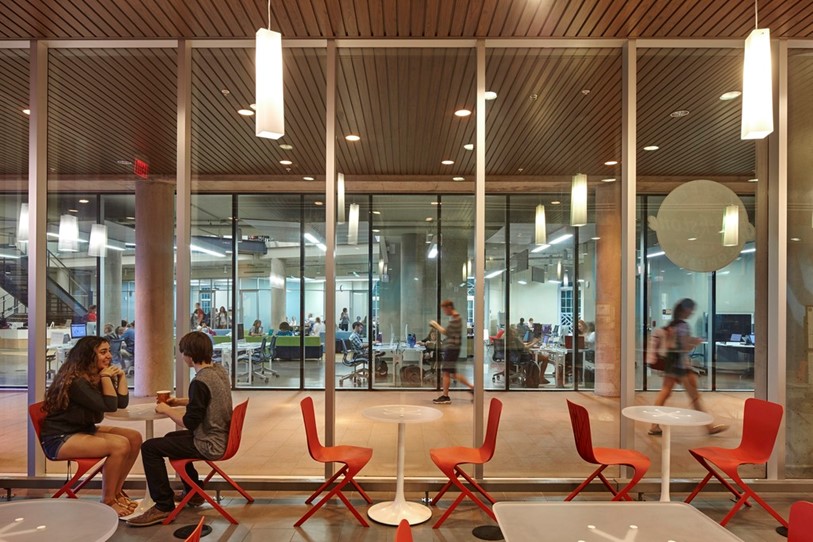
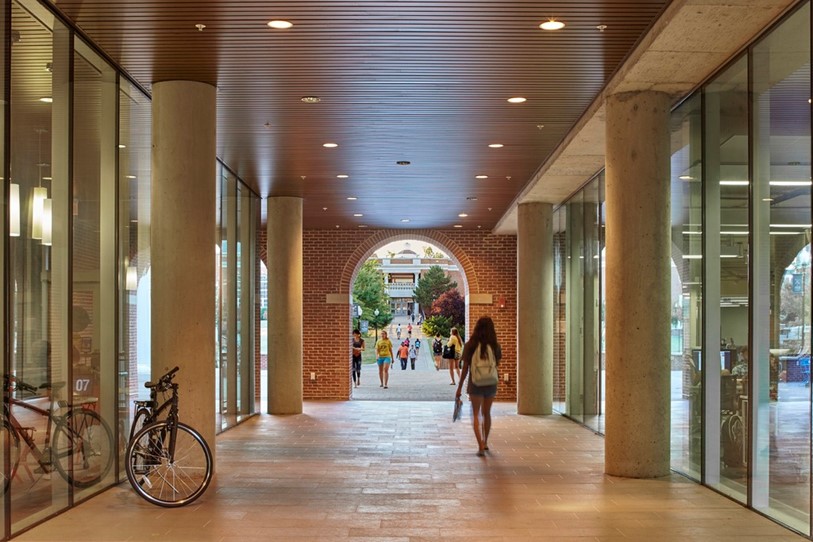
Some schools are also using glass to showcase learning environments and inspire curiosity or ambition. At Norfolk Academy, Virginia’s oldest independent school for grades 1-12, new classroom multipurpose collaboration space, with full walls of sliding glass panel doors, invites younger students to watch older colleagues and, hopefully, envision themselves in those seats someday, too.
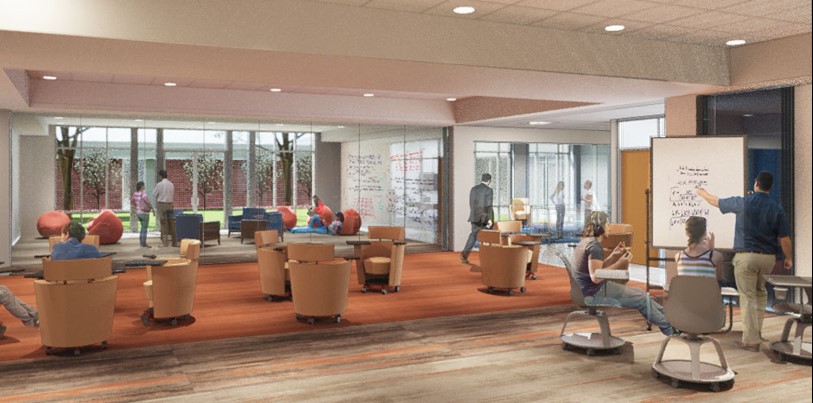
As in the workplace, the right mix of open and private is needed on campuses. Some schools have found that glass in classrooms is too distracting. The type of classroom, and the type of student, needs to be considered in the design process. The high cost of glass will also be a factor that is likely to govern its judicious use.
More focus on relationships
In his book, “What Matters in College,” author Alexander Astin states that connections between students have the biggest influence on a student’s development.
That same thinking drives building and space design. The Bloomberg Tower in Manhattan doesn’t even have elevators that stop at every floor. Instead, glass staircases connect many of the floors, forcing employees to mingle, which was the desired intent.
On college campuses, we now see more bridging hallways and open air colonnades rather than closed corridors and hallways. Such designs underscore the understanding that even connecting spaces can spur relationship building. Spaces where people serendipitously meet—even if those people are from different departments on campus—provide opportunities for collaboration, idea generation and friendship.
Stanford University’s Center for Clinical Sciences Research deploys ample use of glass that provides flexible, light-filled workspaces. Meanwhile, a shaded courtyard invites social interactions. Offices that overlook the courtyard get privacy from a stand of bamboo.
MIT’s five-story contemporary glass addition, the PDSI building, boasts inner bridges, public areas and walkways that are “programmed to increase casual interaction among researchers,” wrote an author in Tradeline.
What’s more, PDSI’s use of glass allows views of the internal historic courtyard facades — as well as into glass-enclosed workspaces. Privacy is protected because vantage points are far enough away so that, while you see people working and interacting, you don’t see specifically what’s being done.
What Students Want
Today’s college and university students grew up amid the proliferation of the open office floor plan, emerging as a mid-century concept and fully evolving over the last 25 years. They watched parents move out of closed door offices and high-walled cubicles into workspaces where employees could more easily see each other and interact.
The students that’ll hit campuses ten or twenty years hence will have grown up with the workplaces of Facebook and Google—with their wide open dynamic workplaces—as the norm. Younger faculty, too, are already accustomed to more open, fluid spaces. They’ll both be looking for campus spaces that feel inviting and familiar. Let’s just hope they don’t expect free food, too.
